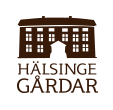Who made these interiors?
-
-
- Who made these interiors?
-
-
In the Hälsingland farmhouses there are paintings by academically trained painters, and both those who learned the trade from a master painter and those who were self-taught.
Strikingly, the painters were often soldiers or their sons – people of the middling sort in the parish.
The Dalarna painters were especially active in Voxnadalen and Rengsjö, wandering from farm to farm and offering their services. Their wives and children sometimes took part in the work.
Some famous names are Wallström, Hofrén, Åsberg, Ädel, and the Knutes boys. Jonas Wallström (1798–1862) was a very skilled painter who did numerous interiors himself and likely inspired others. He was born in Vallsta, Arbrå Parish, and returned there after his education in places such as Hudiksvall and Stockholm. He associated with other painters in the district, such as Olof Hofrén (1813–1856) and Anders Åsberg (1779–1864). Olof Hofrén trained at the art academy in Stockholm, and worked mostly with church interiors. Anders Åsberg had many occupations; he was a woodworker and a self-taught painter.
Anders Ädel is a famous country painter from Ljusdal, one of the last in a long series of practitioners of the floral paintings characteristic of northwestern Hälsingland. This was characterized by a simple, light decorative style that also came to be called “Ädelmåleri”. Ädel never signed his work. He was born in 1809, in Söderhamn. After an impoverished childhood, and later a period as a servant, he enlisted as a soldier in Järvsö Company, Hälsinge Regiment. He died in Ljusdal in 1888.
The “Knutes boys” were the eight sons and grandsons of Knutes Olof ErsSon (1780–1849) in the parishes of Lisselskog and Rättvik. Their paintings can be found from Västmanland to Härjedalen, but are most common in Hälsingland.


